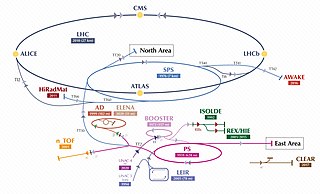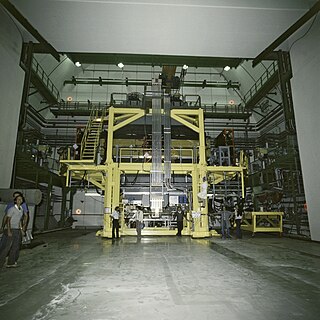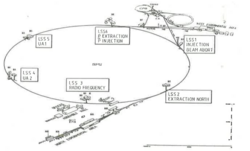
The Compact Muon Solenoid (CMS) experiment is one of two large general-purpose particle physics detectors built on the Large Hadron Collider (LHC) at CERN in Switzerland and France. The goal of CMS experiment is to investigate a wide range of physics, including the search for the Higgs boson, extra dimensions, and particles that could make up dark matter.

The Large Hadron Collider (LHC) is the world's largest and highest-energy particle collider. It was built by the European Organization for Nuclear Research (CERN) between 1998 and 2008 in collaboration with over 10,000 scientists and hundreds of universities and laboratories, as well as more than 100 countries. It lies in a tunnel 27 kilometres (17 mi) in circumference and as deep as 175 metres (574 ft) beneath the France–Switzerland border near Geneva.

ATLAS is the largest, general-purpose particle detector experiment at the Large Hadron Collider (LHC), a particle accelerator at CERN in Switzerland. The experiment is designed to take advantage of the unprecedented energy available at the LHC and observe phenomena that involve highly massive particles which were not observable using earlier lower-energy accelerators. ATLAS was one of the two LHC experiments involved in the discovery of the Higgs boson in July 2012. It was also designed to search for evidence of theories of particle physics beyond the Standard Model.

H1 was a particle detector that operated at HERA in DESY, Hamburg. The first studies for the H1 experiment have proposed in 1981 and the H1 detector began operating together with HERA in 1992 and took data until 2007. The detector consisted of several different detector components and was about 12 x 15 x 10 meters big and weighs 2800 tons. It was accompanied by further detectors in both directions of the HERA accelerator and by an electronics trailer three stories high.

The Underground Area 2 (UA2) experiment was a high-energy physics experiment at the Proton-Antiproton Collider — a modification of the Super Proton Synchrotron (SPS) — at CERN. The experiment ran from 1981 until 1990, and its main objective was to discover the W and Z bosons. UA2, together with the UA1 experiment, succeeded in discovering these particles in 1983, leading to the 1984 Nobel Prize in Physics being awarded to Carlo Rubbia and Simon van der Meer. The UA2 experiment also observed the first evidence for jet production in hadron collisions in 1981, and was involved in the searches of the top quark and of supersymmetric particles. Pierre Darriulat was the spokesperson of UA2 from 1981 to 1986, followed by Luigi Di Lella from 1986 to 1990.

The UA1 experiment was a high-energy physics experiment that ran at CERN's Proton-Antiproton Collider, a modification of the one-beam Super Proton Synchrotron (SPS). The data was recorded between 1981 and 1990. The joint discovery of the W and Z bosons by this experiment and the UA2 experiment in 1983 led to the Nobel Prize for physics being awarded to Carlo Rubbia and Simon van der Meer in 1984. Peter Kalmus and John Dowell, from the UK groups working on the project, were jointly awarded the 1988 Rutherford Medal and Prize from the Institute of Physics for their outstanding roles in the discovery of the W and Z particles.

The Super Proton Synchrotron (SPS) is a particle accelerator of the synchrotron type at CERN. It is housed in a circular tunnel, 6.9 kilometres (4.3 mi) in circumference, straddling the border of France and Switzerland near Geneva, Switzerland.

ALICE is one of eight detector experiments at the Large Hadron Collider at CERN. The other seven are: ATLAS, CMS, TOTEM, LHCb, LHCf, MoEDAL and FASER.

The TOTEM experiment is one of the eight detector experiments at CERN's Large Hadron Collider. The other seven are: ATLAS, ALICE, CMS, LHCb, LHCf, MoEDAL and FASER. It shares an interaction point with CMS. The detector aims at measurement of total cross section, elastic scattering, and diffraction processes. The primary instrument of the detector is referred to as a Roman pot. In December 2020, the D0 and TOTEM Collaborations made public the odderon discovery based on a purely data driven approach in a CERN and Fermilab approved preprint that was later published in Physical Review Letters. In this experimental observation, the TOTEM proton-proton data in the region of the diffractive minimuma and maximum was extrapolated from 13, 8, 7 and 2.76 TeV to 1.96 TeV and compared this to D0 data at 1.96 TeV in the same t-range giving an odderon significance of 3.4 σ. When combined with TOTEM experimental data at 13 TeV at small scattering angles providing an odderon significance of 3.4 - 4.6 σ, the combination resulted in an odderon significance of at least 5.2 σ.

The ISR was a particle accelerator at CERN. It was the world's first hadron collider, and ran from 1971 to 1984, with a maximum center of mass energy of 62 GeV. From its initial startup, the collider itself had the capability to produce particles like the J/ψ and the upsilon, as well as observable jet structure; however, the particle detector experiments were not configured to observe events with large momentum transverse to the beamline, leaving these discoveries to be made at other experiments in the mid-1970s. Nevertheless, the construction of the ISR involved many advances in accelerator physics, including the first use of stochastic cooling, and it held the record for luminosity at a hadron collider until surpassed by the Tevatron in 2004.

The DØ experiment was a worldwide collaboration of scientists conducting research on the fundamental nature of matter. DØ was one of two major experiments located at the Tevatron Collider at Fermilab in Batavia, Illinois. The Tevatron was the world's highest-energy accelerator from 1983 until 2009, when its energy was surpassed by the Large Hadron Collider. The DØ experiment stopped taking data in 2011, when the Tevatron shut down, but data analysis is still ongoing. The DØ detector is preserved in Fermilab's DØ Assembly Building as part of a historical exhibit for public tours.
The Roman pot is the name of a technique used in accelerator physics. Named after its implementation by the CERN Rome group in the early 1970s, it is an important tool to measure the total cross section of two particle beams in a collider. They are called pots because the detectors are housed in cylindrical vessels. The first generation of Roman pots was purpose-built by the CERN Central Workshops and used in the measurement of the total cross-section of proton-proton inter-actions in the ISR.

David George Charlton is Professor of Particle Physics in the School of Physics and Astronomy at the University of Birmingham, UK. From 2013 to 2017, he served as Spokesperson of the ATLAS experiment at the Large Hadron Collider at CERN. Prior to becoming Spokesperson, he was Deputy Spokesperson for four years, and before that Physics Coordinator of ATLAS in the run-up to the start of collision data-taking.

Peter Jenni, is an experimental particle physicist working at CERN. He is best known as one of the "founding fathers" of the ATLAS experiment at the CERN Large Hadron Collider together with a few other colleagues. He acted as spokesperson of the ATLAS Collaboration until 2009. ATLAS is a world-wide collaboration which started in 1992 involving roughly 3,000 physicists at 183 institutions in 38 countries. Jenni was directly involved in the experimental work leading to the discoveries of the W and Z bosons in the 1980s and the Higgs boson in 2012. He is (co-)author of about 1000 publications in scientific journals.

The Future Circular Collider (FCC) is a proposed post-LHC particle accelerator with an energy significantly above that of previous circular colliders. The FCC project examines scenarios for three different types of particle collisions: hadron collisions in a collider design known as FCC-hh, electron–positron collisions in a collider design known as FCC-ee, and proton–electron collisions in a collider design known as FCC-eh.

Luigi Di Lella is an Italian experimental particle physicist. He has been a staff member at CERN for over 40 years, and has played an important role in major experiments at CERN such as CAST and UA2. From 1986 to 1990 he acted as spokesperson for the UA2 Collaboration, which, together with the UA1 Collaboration, discovered the W and Z bosons in 1983.

Pierre Darriulat is a French experimental particle physicist. As staff member at CERN, he contributed in several prestigious experiments. He was the spokesperson of the UA2 collaboration from 1981 to 1986, during which time the UA2 collaboration, together with the UA1 collaboration, discovered the W and Z bosons in 1983.

The Super Proton–Antiproton Synchrotron was a particle accelerator that operated at CERN from 1981 to 1991. To operate as a proton-antiproton collider the Super Proton Synchrotron (SPS) underwent substantial modifications, altering it from a one beam synchrotron to a two-beam collider. The main experiments at the accelerator were UA1 and UA2, where the W and Z boson were discovered in 1983. Carlo Rubbia and Simon van der Meer received the 1984 Nobel Prize in Physics for their decisive contribution to the SppS-project, which led to the discovery of the W and Z bosons. Other experiments conducted at the SppS were UA4, UA5 and UA8.

The UA5 experiment was the first experiment conducted at the Proton-Antiproton Collider, a collider using the infrastructure of the Super Proton Synchrotron (SPS). The experiment was approved in February 1979, as a collaboration between CERN and the universities of Bonn, Brussels, Cambridge and Stockholm. The spokesperson of the UA5 collaboration was John Rushbrooke.

UA4 experiment (COULOMB) was a high-energy physics experiment at the Proton-Antiproton Collider at CERN. The UA4 collaboration consisted of physicists from Amsterdam, Genova, Napoli, Pisa, Roma, California and CERN. UA4 was approved on 18 January 1979, and the first phase of data taking lasted until 17 June 1985. The spokesperson of UA4 was Giorgi Matthiae.














